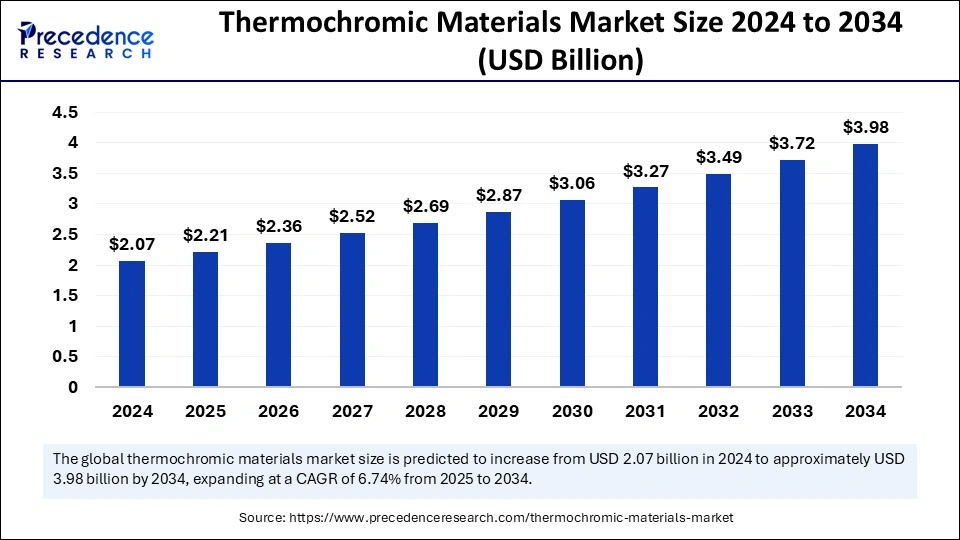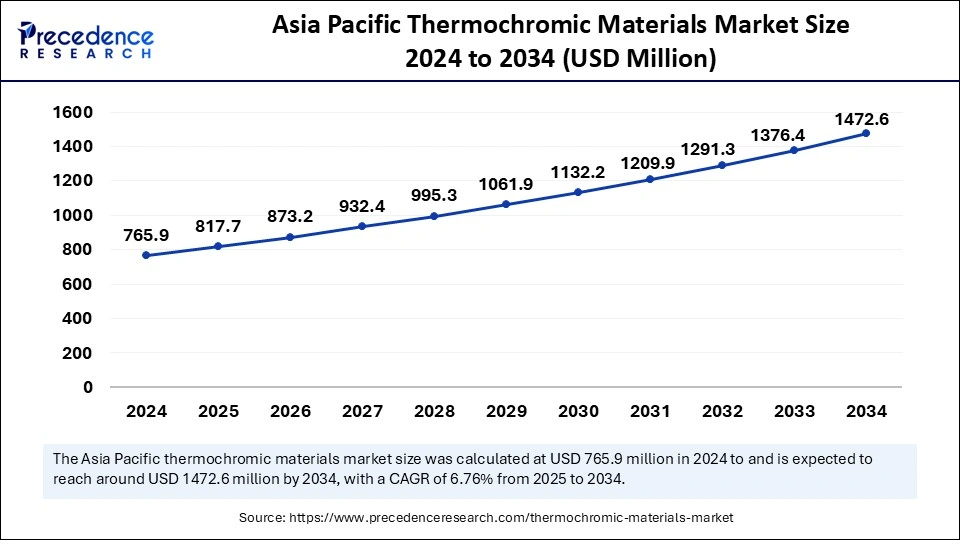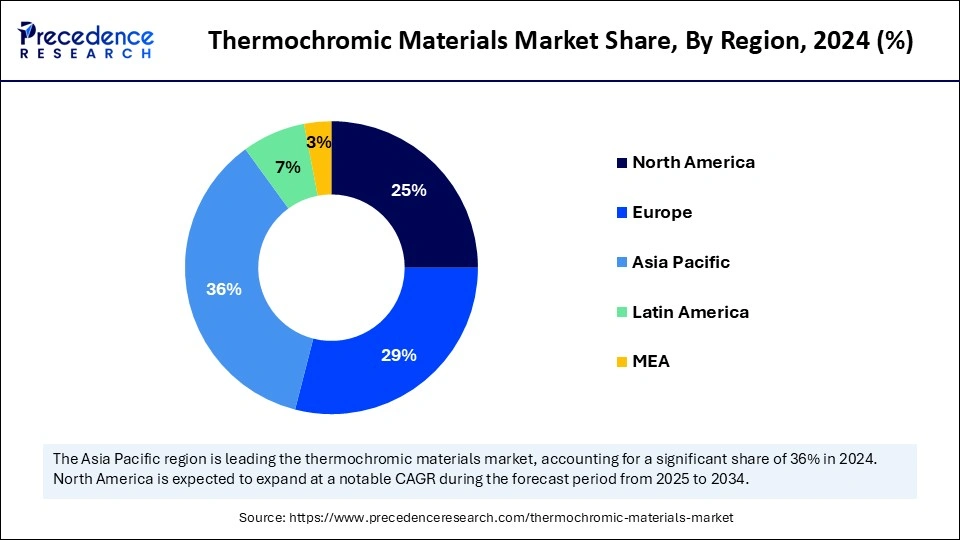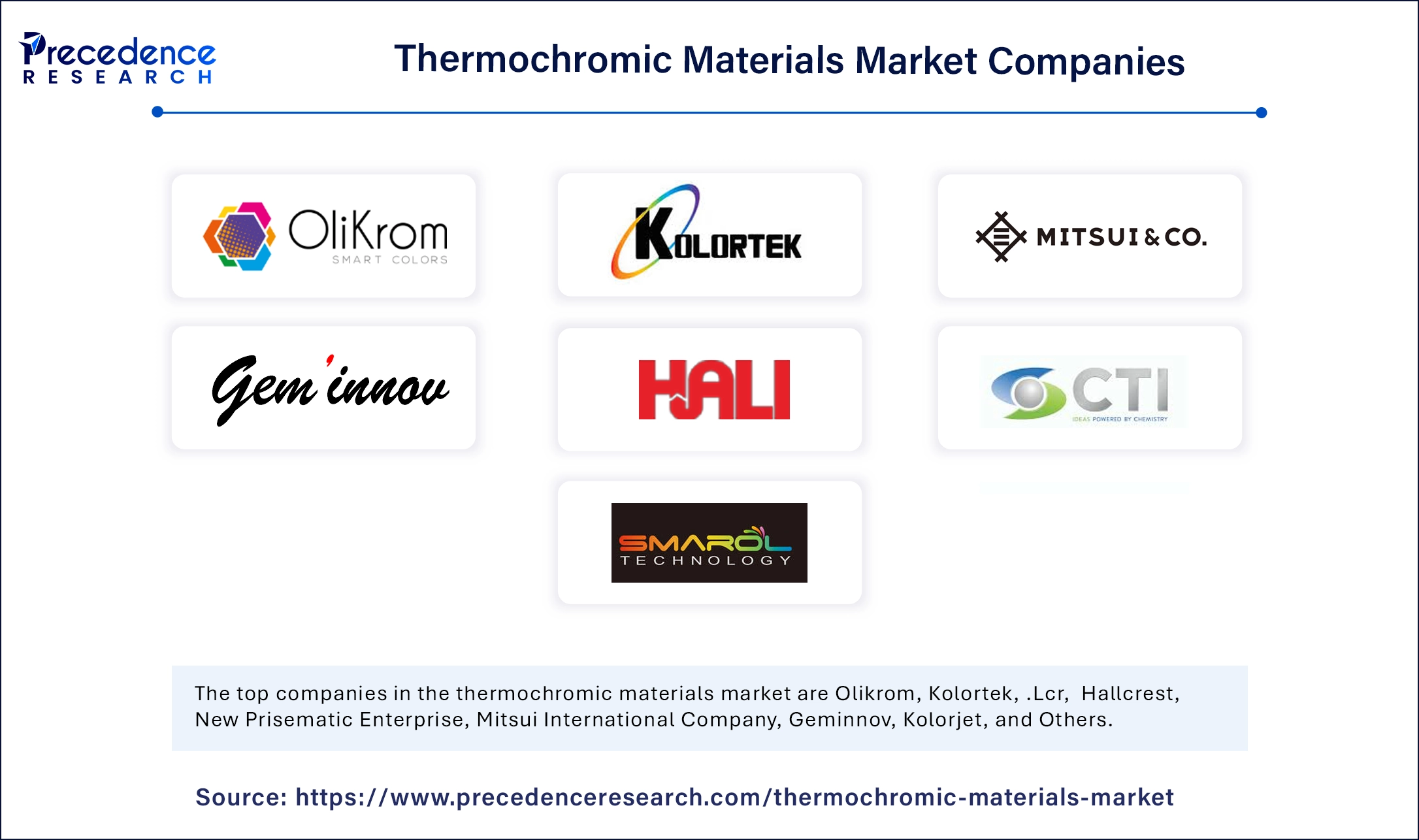List of Contents
What is the Thermochromic Materials Market Size?
The global thermochromic materials market size is valued at USD 2.21 billion in 2025 and is predicted to increase from USD 2.36 billion in 2026 to approximately USD 3.98 billion by 2034, expanding at a CAGR of 6.74% from 2025 to 2034. The thermochromic materials market is experiencing steady growth, driven by increasing adoption of thermochromic materials in smart packaging, textiles, and temperature-sensitive applications across automotive, consumer goods, and building sectors.

Thermochromic Materials Market Key Takeaways
- Asia Pacific dominated the global market with the largest market share of 37% in 2024.
- North America is estimated to expand at the fastest CAGR between 2025 and 2034.
- By type, the irreversible segment held the largest market share in 2024.
- By type, the reversible segment is anticipated to grow at a remarkable CAGR during the forecast period.
- By material, the leuco dyes segment captured the biggest market share in 2024.
- By material, the liquid crystals segment is expected to expand at a significant rate over the projected period.
- By end-use industry, the packaging segment dominated the market in 2024.
- By end-use industry, the printing and coating segment is expected to expand at a notable CAGR over the projected period.
Artificial Intelligence: The Next Growth Catalyst in Thermochromic Materials
AI is advancing the arena of smart materials. Artificial intelligence have the ability to improve synthesis methods that help researchers develop advanced thermochromic materials that are more efficient and durable. By predicting molecular-level interactions, AI helps to accelerate the discovery of new thermochromic materials. In 2024, MIT announced that researchers can use AI-driven simulations to create a new class of thermochromic materials that change color with increased precision and stability, which ultimately decreases the harm to the environment by employing non-toxic compounds. Colorifix is actively utilizing AI-based dye technologies. Colorifix is employing machine learning algorithms to produce a thermochromic dye that will help reduce water usage and increase the durability of the color change over time.
Strategic Overview of the Global Thermochromic Materials Industry
Thermochromic materials find applications in various industries, including consumer goods, packaging, textiles, automotive, and electronics. Thermochromic materials come in forms such as pigments, inks, and dyes. These materials can be applied as temperature indicators in industrial applications like thermometers, battery testers, fraud deterrents, and food temperature indicators. They absorb and reflect certain wavelengths of light in products. When thermochromic materials absorb heat, their chemical or physical structure changes so that they reflect a different color. The thermochromic materials market is expanding rapidly due to increased demand for new, interactive, customizable products. Advances in material technologies further contribute to market growth.
Thermochromic Materials Market Growth Factors
- Consumer demand for novelty products: As consumer interest increases in new, interactive, and personalized products, the demand for thermochromic materials increases. These materials are used in clothing and accessories that change colors.
- Smart textiles and wearable technology: As wearable technology and smart fabrics gain popularity, the demand for thermochromic materials used for interactive features and temperature-sensitive textiles also increase.
- Sustainability trends: The rising focus on reducing energy consumption is likely to boost the adoption of thermoplastic materials in several applications as these materials offer energy-saving solutions.
- Demand for consumer electronics: The rising demand for consumer electronics is expected to boost market growth. Thermochromic materials are used in smartphones, laptops, and tablets for temperature-sensitive displays.
Market Outlook
- Market Growth Overview: The Thermochromic Materials market is expected to grow significantly between 2025 and 2034, driven by smart packaging, textiles, and energy-efficient applications. The rising demand for visual temperature indicators, especially for food safety, and the increasing consumer interest in interactive products.
- Sustainability Trends: Sustainability trends involve energy efficiency in end-use applications, development of eco-friendly materials, and west reduction and food safety.
- Major Investors: Major investors in the market include Merck KGaA, Chromatic Technologies Inc., LCR Hallcrest LLC, OliKrom, and Matsui International Company.
- Startup Economy: The startup economy is focused on niche and design-based innovation, acquisitions by larger players, and expansion into specialized applications.
Market Scope
| Report Coverage | Details |
| Market Size by 2034 | USD 3.98 Billion |
| Market Size by 2025 | USD 2.21 Billion |
| Market Size by 2026 | USD 2.36 Billion |
| Market Growth Rate from 2025 to 2034 | CAGR of 6.74% |
| Dominated Region | Asia Pacific |
| Fastest Growing Market | North America |
| Base Year | 2024 |
| Forecast Period | 2025 to 2034 |
| Segments Covered | Type, Material, End-use Industry, and Regions |
| Regions Covered | North America, Europe, Asia-Pacific, Latin America, and the Middle East & Africa |
Market Dynamics
Drivers
Expanding Scope of Applications
Expanding the scope of applications of thermochromic materials is a key factor driving the growth of the thermochromic materials market. These materials are used in a range of applications, including packaging, textiles, automotive, and consumer electronics. The addition of thermochromic materials into wearable technology greatly improves functionality and attractiveness. These materials change color reversibly in response to changes in temperature, enabling dynamic displays. In the textile industry, these materials enable the development of thermochromic fibers that become purple, blue, and finally white, as temperature rises from 25°C to 37°C. These fibers retain their color after repeated stretching, exposure to human sweat, washing, and cleaning solutions. These fibers demonstrate excellent color-changing ability, making them suitable for woven fabrics to produce color-changing QR codes.
Restraint
High Production Costs and Durability Challenges
One significant challenge for the thermochromic material industry is the substantial investment required for producing thermochromic materials. Producing thermochromic materials requires specialized chemicals and manufacturing processes, leading to high production costs. This can limit the adoption of these materials and significantly applications in industries, especially those with budget constraints. Thermochromic materials often have limited durability and stability, limiting their adoption.
Opportunity
Increasing Demand from the Textile Industry
As the application of thermochromic material in the textile sector continues to grow, the thermochromic materials market is poised to grow rapidly in the coming years. This is the most promising area for expansion of the market. Several fashion designers integrate thermochromic materials into their products. Thermochromic materials are advanced substances that detect and react to changes in environmental temperature by changing their color or optical properties. They are progressively being used in the textile and fashion industry to create interactive and visually attractive products. Some companies are also developing “smart textiles.” For example, thermochromic materials are used to make sportswear that can adapt to regulate body temperature when an athlete reaches their target during a workout. Thermochromic materials open up various possibilities for smart clothing, adaptive camouflage, and other applications. The textile industry is poised for an exciting transformation with thermochromism.
Type Insights
The irreversible segment dominated the thermochromic materials market with the largest share in 2024. The segment growth is driven by the rising demand for permanent indicators and specialized sensors that require a single-color change. Irreversible thermochromic materials are primarily used in medical and food & beverage packaging and security labels. Furthermore, their unique properties make them suitable for security inks and temperature-sensitive packaging.
The reversible segment is anticipated to grow at a remarkable CAGR during the forecast period. Reversible thermochromic materials are increasingly being used because they can change color in response to changes in temperature and then be returned to their original state. This stimulus-response characteristic makes them particularly advantageous in any circumstance or application where temperature monitoring is necessary, such as food packaging, health-related products, and consumer electronics. Another reason for rapid adoption is the advances in formulation that allow for even more specificity over color change. Companies are integrating reversible thermochromic materials into an ever-increasing number of products within consumer goods, toys, and smart textiles where interactive products are in high demand.
Material Insights
The leuco dyes segment captured the largest share of the thermochromic materials market in 2024. Leuco dyes are widely used due to their strong color-change properties and ease of incorporation into varying product formulations. Leuco dyes change color upon heat exposure, making them very effective for use in packaging, toys, and novelty items. Their versatility and durability, as well as the numerous colors that can be achieved, contribute to their status as a first choice for manufacturers. The rise in the adoption of leuco dyes in printing and packaging bolstered the segment growth.
The liquid crystals segment is expected to expand at a significant rate over the projected period. Liquid crystals are utilized in products such as thermometers, temperature indicators, and smart textiles, which facilitate very accurate temperature-specific and reversible color changes. They are also used in wearable technology and medical devices due to their ability to precisely control temperature.
End-Use Industry Insights
The packaging segment dominated the thermochromic materials market in 2024. This is mainly due to the rise in the demand for interactive and smart packaging solutions. Thermochromic inks and coatings can be printed on the packaging to change color when the temperature changes. This will further provide a visual cue for the consumer regarding product freshness, product safety, or storage conditions. The common food and beverage packaging, as well as pharmaceuticals and other temperature-sensitive products, make up the use of thermochromic materials to provide some visual understanding of the packaging to the consumer.
The printing & coating segment is expected to expand at a notable CAGR over the projected period. The growth of the segment can be attributed to the rising demand for unique, customized, and interactive labels for packaging. It is now possible to utilize a thermochromic ink that changes color, providing a distinct design aesthetic and an interactive element to printed products. As consumers enjoy personalized and interactive experiences, thermochromic materials will appear more often in printing and coating applications.
Regional Insights
Asia Pacific Thermochromic Materials Market Size and Growth 2025 to 2034
The Asia Pacific thermochromic materials market size is exhibited at USD 817.7 million in 2025 and is projected to be worth around USD 1472.6 million by 2034, growing at a CAGR of 6.76% from 2025 to 2034.

Asia Pacific: China Thermochromic Materials Trends
Asia Pacific dominated the thermochromic materials market by capturing the largest share in 2024. This is mainly due to the increased manufacturing capabilities, automotive production, and new technological developments. China, Japan, and South Korea are at the forefront of the production of consumer electronics, textiles, packaging, and temperature-sensitive ink, boosting the demand for thermochromic materials. Additionally, the boom of e-commerce is a significant contributing factor. This increased the demand for smart, interactive packaging, in which thermochromic materials play a crucial role.
China is a major contributor to the Asia Pacific thermochromic materials market, supported by a large manufacturing sector and the growing adoption and development of new technologies. The country has made strides toward the integration of thermochromic materials into its automotive, packaging, and electronics industries. For example, the use of thermochromic materials to develop smart packaging and interactive products represents an emerging market. The government inChina has provided the encouragement of such innovation through policies that support high-tech industries and sustainable manufacturing. In addition, Chinese companies have invested in research and development to produce greater efficiency and more cost-effective thermochromic products, enabling the country to expand in its own domestic market.
North America: U.S. Thermochromic Materials Market Trends
The U.S. market is seeing strong growth in smart packaging, with thermochromic pigments being used as temperature-sensitive indicators in food and beverage applications. Innovations in healthcare and diagnostics are driving demand for thermochromic materials in medical devices and cold-chain packaging. There's increasing adoption of reversible thermochromic systems, like leuco dyes, in textiles and coatings for interactive and energy-efficient products.
North America is expected to witness the fastest growth during the forecast period. This is mainly due to advancements in technologies and increasing demand from multiple industries such as automotive, packaging, and consumer goods. North America has a strong industrial base. There is a high demand for thermochromic inks and coatings that are being used for packaging, temperature-sensitive products, and automotive applications to regulate thermal properties. North American manufacturers are increasingly using thermochromic pigments in interactive packaging, labels, and healthcare applications. The U.S. can have a stronghold on the North American thermochromic materials market due to its significant manufacturing base and large-scale consumer goods production. The government of the U.S. has been advocating sustainability initiatives, which has led to the acceptance of thermochromic materials for sustainable packaging.

Germany Thermochromic Materials Market Trends
Germany's thermochromic materials market expansion of smart packaging and the rapid growth of smart textiles and wearables. A strong emphasis on developing sustainable and energy-efficient applications, such as temperature indicators for food safety and intelligent coatings for buildings. Technological innovation focuses on improving material stability and response time to enable broader use in specialized fields like automotive and medical devices.
Europe is considered to be a significantly growing area. The thermochromic materials market in Europe is expanding steadily, supported by a combination of technological improvements and environmentally friendly regulations. The EU's commitment to lowering carbon emissions and improving recycling procedures has resulted in an increase in the use of sustainable thermochromic materials. Growing usage of smart textiles, eco-friendly packaging, and energy-efficient coatings further stimulate market growth. Moreover, the rising manufacturing activities support regional market growth.
Thermochromic Materials Market-Value Chain Analysis
- Raw Material Sourcing and Chemical Production
This foundational stage involves procuring basic chemicals such as organic dyes, leuco dyes, solvents, and microencapsulation materials required for creating thermochromic compounds.
Key Players: BASF SE, Huntsman Corporation, and Merck KGaA - Thermochromic Material Manufacturing and Compounding
In this stage, the raw materials are formulated into functional thermochromic pigments, powders, and masterbatches.
Key Players: LCR Hallcrest, Chromatic Technologies, Inc. (CTI), Matsui Shikiso Chemical Co., Ltd., and OliKrom S.A.S. - Intermediate Product Production (Coatings, Inks, Films)
The manufactured pigments are then incorporated into intermediate products such as specialized coatings, printing inks, and thin films.
Key Players: LCR Hallcrest, Chromatic Technologies, Inc. (CTI), OliKrom S.A.S., various specialized ink, and coating manufacturers. - End-Product Manufacturing and Integration
This stage involves integrating the thermochromic inks, coatings, or films into the final consumer or industrial products, such as smart packaging, textiles, toys, or medical devices.
Key Players: Crown Holdings Inc. - Distribution, Marketing, and End-Users
The finished products are distributed to market through various channels to reach the final end-users, including consumers, medical professionals, and industrial clients.
Top Companies in the Thermochromic Materials Market & Their Offerings:
- OliKrom S.A.S.: OliKrom specializes in the research, development, and industrial production of custom smart pigments and inks that change color based on temperature variations.
- Kolortek Co., Ltd.: Kolortek manufactures and supplies a wide range of effect pigments, including thermochromic pigments, which are used in coatings, plastics, cosmetics, and inks.
- LCR Hallcrest: A dominant player in the market, LCR Hallcrest specializes in formulating and manufacturing both reversible and irreversible thermochromic liquid crystals, inks, and labels for food safety, medical, and industrial temperature monitoring.
- New Prismatic Enterprise Co., Ltd.: This company offers a variety of thermochromic and photochromic pigments and masterbatches, catering to the plastics, coatings, and ink industries. They focus on providing functional color-change technology for toys, textiles, and consumer goods.
- Mitsui International Company (part of Mitsui & Co., Ltd.): As a global trading and investment firm, Mitsui facilitates the distribution of specialty chemicals and materials, including thermochromic products, through its vast international network. They play a key role in the supply chain, connecting manufacturers with global markets and strategic partnerships.
- Geminnov: Geminnov focuses on developing and integrating smart materials, including thermochromic solutions, into advanced industrial applications through R&D and engineering services. Their contribution lies in technological innovation and the creation of bespoke solutions for complex industrial challenges.
- Kolorjet: (Note: Information is scarce, likely a regional/smaller player or distributor.) Kolorjet is a supplier in the specialty chemicals domain, likely offering pigments and dyes that include thermochromic properties for regional ink and paint manufacturers.
- Hali Industrial Co., Ltd. (Smarol Industry Co., Ltd. is often linked or related): Hali/Smarol is primarily a manufacturer and supplier of thermochromic and photochromic pigments and products, focusing heavily on the Chinese and broader Asian markets. They provide color-changing materials for novelty items, textiles, and packaging applications.
- Chromatic Technologies, Inc. (CTI): CTI is a major innovator in the thermochromic ink market, known for its focus on practical applications, particularly in food safety, beverage packaging, and security printing. They develop specialized inks that provide visual quality indicators, enhancing consumer safety and brand value.
- Smarol Industry (See Hali Industrial): Smarol focuses on producing various intelligent pigments, including thermochromic materials, for use in a wide array of consumer goods. They contribute to the market by supplying functional, colour-changing materials for applications such as toys, textiles, and cosmetics.
Thermochromic Materials Market Companies

- Olikrom
- Kolortek, .Lcr
- Hallcrest
- New Prisematic Enterprise
- Mitsui International Company
- Geminnov
- Kolorjet
- Hali Industrial
- Chromatic Technologies
- Smarol Industry
Recent Developments
- In January 2025, Realme launched Realme 14 Pro+ smartphone, a back panel that changes color in response to temperature fluctuations. This unique feature utilizes thermochromic materials, offering designers across disciplines a fresh perspective on the potential of dynamic and responsive materials. Also, Realme collaborated with Walter Design, a Copenhagen-based studio specialising in material innovation, to perfect the aesthetic and functional aspects of the smartphone's thermochromic back panel.
- In June 2023, Good Life Innovations Ltd. announced the launch of a new range of thermochromic microcapsules for use in food and beverage packaging. These novel microcapsules are used to produce temperature-responsive packaging and are safe for food contact.
Segments Covered in the Report
By Type
- Reversible
- Irreversible
By Material
- Leuco Dyes
- Liquid crystals
- Pigments
- Others
By End-use Industry
- Packaging
- Printing & Coating
- Medical
- Textile
- Industrial
- Others
By Region
- North America
- Europe
- Asia-Pacific
- Latin America
- Middle East and Africa
For inquiries regarding discounts, bulk purchases, or customization requests, please contact us at sales@precedenceresearch.com
Frequently Asked Questions
Ask For Sample
No cookie-cutter, only authentic analysis – take the 1st step to become a Precedence Research client